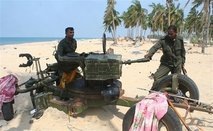 Satellite images of Sri Lanka’s war zone along with witness accounts indicate the government has shelled the densely populated area in recent days despite its repeated denials, a human rights group said Wednesday.
Satellite images of Sri Lanka’s war zone along with witness accounts indicate the government has shelled the densely populated area in recent days despite its repeated denials, a human rights group said Wednesday.
Health officials in the tiny coastal strip still under rebel control say the area was repeatedly pummeled by artillery attacks — including the shelling of a hospital — that killed as many as 1,000 civilians in recent days as the government pushed ahead with its offensive.
British Foreign Secretary David Miliband called the conflict zone "as close to hell as you can get," and Secretary of State Hillary Rodham Clinton expressed alarm at the civilian casualties.
The fighting raged on Wednesday, with government forces fighting off a rebel attempt to recapture territory in a sea attack, destroying three rebel boats, military spokesman Brig. Udaya Nanayakkara said.
On Tuesday, a shell landed in a makeshift hospital, killing 49 people, health officials said. The rebels blamed the government for the attack. The government denied it, and has said several times that it stopped firing heavy weapons into the war zone weeks ago out of deference to the thousands of ethnic Tamil civilians trapped by the fighting
Reports of the fighting are difficult to verify because the government has barred journalists and aid workers from the war zone.
However, Human Rights Watch said witness testimony and satellite images of the area taken Sunday and analyzed by experts "contradict Sri Lankan government claims that its armed forces are no longer using heavy weapons in the densely populated conflict area in northern Sri Lanka."
The group also accused the rebels of using the civilians as human shields and shooting those who try to escape.
"Neither the Sri Lankan army nor the Tamil Tigers appear to have any reluctance in using civilians as cannon fodder," said Brad Adams, Asia director at Human Rights Watch.
The American Association for the Advancement of Science analyzed satellite photos of the area taken Sunday morning — after a night of heavy shelling was reported in the area — and compared it to an image taken four days before. The report was done at the request of Human Rights Watch and Amnesty International.
A preliminary analysis of the images showed a stark change in the area.
"By comparing before-and-after satellite images, we were able to see a significant movement of the region’s human population, suggesting widespread displacement. We also saw destroyed structures and circular, crater-like features consistent with widespread shelling," said Lars Bromley, director of the association’s Geospatial Technologies and Human Rights project.
One area, which had been densely packed with tents and other structures in the earlier photo was nearly empty Sunday morning. Another photo provided by Amnesty showed two white circles near a cluster of trees that were identified as impact craters.
While Bromley said the images did not show who was behind the destruction, Human Rights Watch said a health official in the area had told them the artillery was being fired from an area under the control of government forces.
The military questioned the analysis, saying there was no way to tell how the craters were made since the rebels had been booby trapping buildings and setting off explosives throughout the area.
"The craters may have been created due to that," Nanayakkara said.
As some of the victims of previous shell attacks waited to be treated at the makeshift hospital in the area Tuesday morning, a single mortar shell hit the admissions ward, killing 49 and injuring more than 50 others, said Dr. Thurairaja Varatharajah, the top government health official in the war zone.
The hospital had been hit by artillery May 2, in an attack that killed 64 civilians.
In Washington, Miliband said he had spoken with Sri Lanka’s foreign minister twice to protest amid allegations of indiscriminate shelling of civilians by government troops.
In a joint statement, Miliband and Clinton expressed "profound concern" about the crisis and called for a political solution to the war.
U.N. humanitarian chief John Holmes said the government was still using heavy weapons, though he did not say who was responsible for Tuesday’s attack.
"The government have said they are not using heavy weapons, but the evidence suggests that they are continuing to do so, at least to some extent, and that’s obviously contributing to the dreadful casualty figures that we’ve seen," John Holmes said in Geneva.
U.N. figures compiled last month showed nearly 6,500 civilians had been killed in three months this year as the government drove the rebels from their northern strongholds and vowed to end their war for a separate homeland for minority Tamils.
(For updates you can share with your friends, follow TNN on Facebook and Twitter )
